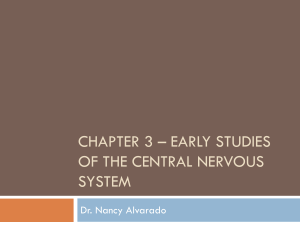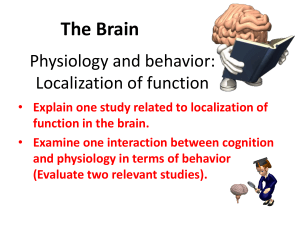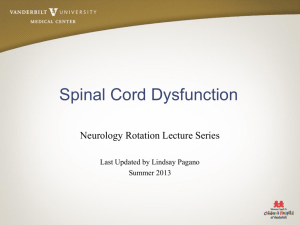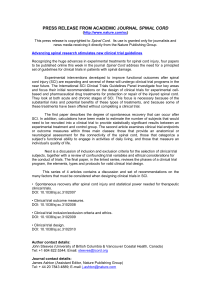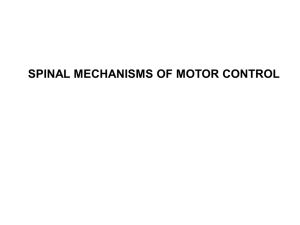Chapter 1
advertisement
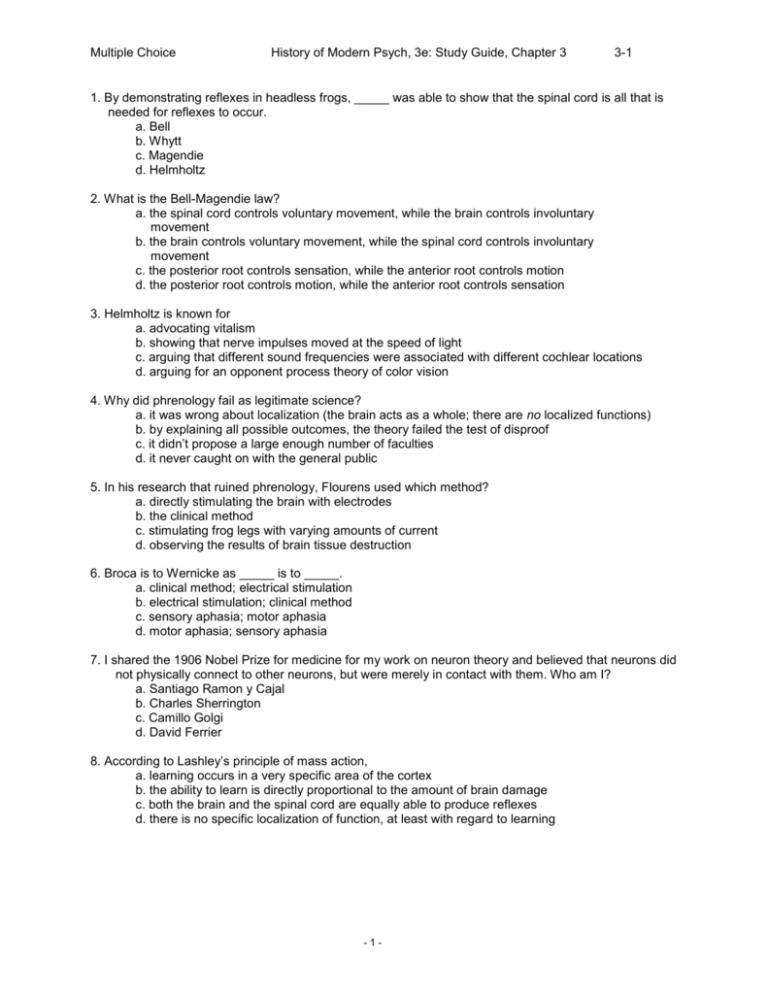
Multiple Choice History of Modern Psych, 3e: Study Guide, Chapter 3 3-1 1. By demonstrating reflexes in headless frogs, _____ was able to show that the spinal cord is all that is needed for reflexes to occur. a. Bell b. Whytt c. Magendie d. Helmholtz 2. What is the Bell-Magendie law? a. the spinal cord controls voluntary movement, while the brain controls involuntary movement b. the brain controls voluntary movement, while the spinal cord controls involuntary movement c. the posterior root controls sensation, while the anterior root controls motion d. the posterior root controls motion, while the anterior root controls sensation 3. Helmholtz is known for a. advocating vitalism b. showing that nerve impulses moved at the speed of light c. arguing that different sound frequencies were associated with different cochlear locations d. arguing for an opponent process theory of color vision 4. Why did phrenology fail as legitimate science? a. it was wrong about localization (the brain acts as a whole; there are no localized functions) b. by explaining all possible outcomes, the theory failed the test of disproof c. it didn’t propose a large enough number of faculties d. it never caught on with the general public 5. In his research that ruined phrenology, Flourens used which method? a. directly stimulating the brain with electrodes b. the clinical method c. stimulating frog legs with varying amounts of current d. observing the results of brain tissue destruction 6. Broca is to Wernicke as _____ is to _____. a. clinical method; electrical stimulation b. electrical stimulation; clinical method c. sensory aphasia; motor aphasia d. motor aphasia; sensory aphasia 7. I shared the 1906 Nobel Prize for medicine for my work on neuron theory and believed that neurons did not physically connect to other neurons, but were merely in contact with them. Who am I? a. Santiago Ramon y Cajal b. Charles Sherrington c. Camillo Golgi d. David Ferrier 8. According to Lashley’s principle of mass action, a. learning occurs in a very specific area of the cortex b. the ability to learn is directly proportional to the amount of brain damage c. both the brain and the spinal cord are equally able to produce reflexes d. there is no specific localization of function, at least with regard to learning -1- Multiple Choice History of Modern Psych, 3e: Study Guide, Chapter 3 3-2 Answers 1. a. Bell investigated anterior and posterior spinal cord roots b. CORRECT ANSWER – headless frogs with intact spinal cords still showed reflexes c. Magendie completed the definitive studies on the anterior and posterior spinal cord roots d. Helmholtz was over a century later that Whytt 2. a. if anything, the opposite is closer to the truth, but neither relates to Bell-Magendie b. similar to Bell’s idea, but not the Bell-Magendie Law c. CORRECT ANSWER – a severed posterior root eliminates sensation but does not affect movement; a severed anterior root eliminates movement but sensation remains d. the opposite 3. a. the opposite – he advocated materialism b. his research disproved this assertion c. CORRECT ANSWER – this was his resonance theory of hearing d. this was Hering – Helmholtz advocated the trichromatic theory 4. a. localization does exist in the brain (e.g., Broca’s area) b. CORRECT ANSWER – apparent disproof could be explained away by an infinite number of combinations of faculties c. 37 was plenty d. it was immensely popular, especially in the United States 5. a. no, this developed after Flourens (e.g., Ferrier) b. no, this was the method used by Broca c. he did not use electrical stimulation d. CORRECT ANSWER – this is his ablation method 6. a. Broca used the clinical method, but Wernike did not use electrical stimulation b. Broca used the clinical method c. the opposite d. CORRECT ANSWER – Broca’s patients could not emit productive speech; Wernicke’s had trouble with comprehension of incoming information 7. a. CORRECT ANSWER – Golgi shared the prize, but he believed neurons were physically connected to each other b. Sherrington investigated synaptic functioning c. Golgi believed neurons were physically connected to each other d. Ferrier did brain mapping studies using electrical stimulation of the cortical surfaces 8. a. he rejected this degree of localization b. CORRECT ANSWER – and in this he agreed with Flourens c. he wasn’t interested in reflexes d. this is his principle of equipotentiality -2-


